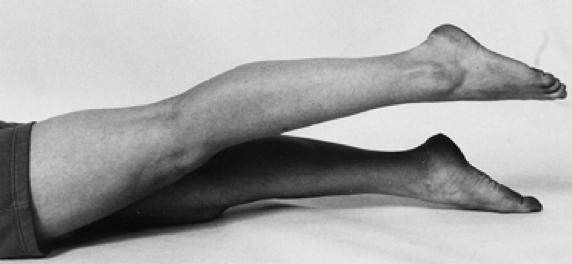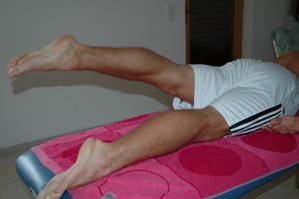The muscles shorten in concentric contraction as you lift the leg, and lengthen out in eccentric contraction as you control the reverse movement.
The exercise trains co-ordination between the vastus medialis obliquus muscle, the other knee extensors (front-thigh muscles), the hip extensors (gluteals and hamstrings) and the calf muscles. It strengthens the hip extensors and the calf muscles in a limited range against gravity, and so helps to prevent or counteract shortening in the hip flexor muscles. Shortening of the hip flexors can happen because of aging, through sitting for long periods, especially on a low chair, as a result of hip or back pain, or because you have limped as the result of some other leg injury. It can be a factor in wear-and-tear arthritis in the hip. This exercise is important for preventing any biomechanical imbalance round the hip or knee which could lead to damage in the joints.

Position: Lie on your stomach with a cushion under your forehead, so that you can keep your head straight and still breathe. Alternatively, if your bed is firm, lie on it with your head over the end, preferably with your neck and chin supported. Your legs should be straight, your feet and toes pointing away from your legs (technically in plantarflexion).
Movement: Lift one leg a little way upwards, making sure your knee stays locked absolutely straight; hold for a count of two, then slowly lower the leg and relax completely.
Repetitions and frequency: 5-20 times, 2-3 times a day
Note: Avoid pain. Only lift a little way, do not arch your back at all. Once you have lifted the leg up, consciously lock the knee straight again, otherwise it may tend to bend slightly. Keep your other leg, your back and your shoulders relaxed. Keep your hands in contact with the floor/bed. Breathe evenly, do not hold your breath. Exercise one leg at a time. If the movement is more difficult on one side than the other, do more repetitions for the more difficult side.
After injury: This exercise is essential after any knee injury, especially injuries to the front of the knee and the kneecap joint, and following any problem affecting the lower back or hip. It should be done in the earliest phase of recovery following any knee problem or operation, within pain limits.
Progression: When you can do the exercise easily, you can use a weighted boot or ankle weight to provide extra loading.
Movement: Lift one leg a little way upwards, making sure your knee stays locked absolutely straight; hold for a count of two, then slowly lower the leg and relax completely.

Repetitions and frequency: 5-20 times, 2-3 times a day
Note: Avoid pain. Only lift a little way, do not arch your back at all. Once you have lifted the leg up, consciously lock the knee straight again, otherwise it may tend to bend slightly. Keep your other leg, your back and your shoulders relaxed. Keep your hands in contact with the floor/bed. Breathe evenly, do not hold your breath. Exercise one leg at a time. If the movement is more difficult on one side than the other, do more repetitions for the more difficult side.
After injury: This exercise is essential after any knee injury, especially injuries to the front of the knee and the kneecap joint, and following any problem affecting the lower back or hip. It should be done in the earliest phase of recovery following any knee problem or operation, within pain limits.
Progression: When you can do the exercise easily, you can use a weighted boot or ankle weight to provide extra loading.


